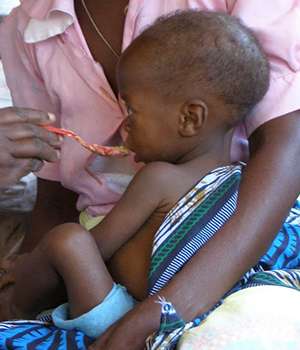Gut microbes targeted for diagnosis, treatment of childhood undernutrition

Guided by the immune system, researchers have identified types of gut bacteria in young children in Malawi that are linked to nutritional health and that have diagnostic and therapeutic implications for childhood undernutrition.
The research, led by Jeffrey I. Gordon, MD, at Washington University School of Medicine in St. Louis, is published Feb. 25 in Science Translational Medicine. The work, funded largely by the Bill & Melinda Gates Foundation, also involved scientists at the University of Malawi in Africa, University of Tampere in Finland and University of California, Davis.
Tens of trillions of microbes live in the gut, where they synthesize vitamins and process nutrients in the diet to keep the body healthy. These microbes and their genes, collectively known as the gut microbiota, begin to colonize the intestinal tract at birth.
Researchers long have known that a lack of food is not the sole contributor to childhood undernutrition; infections and intestinal problems that prevent nutrient absorption are thought to play a role.
A 2013 study by the same group of Washington University scientists pointed to a dysfunctional collection of gut microbes as an underlying cause of childhood undernutrition. These children possessed communities of gut microbes that did not mature as they grew and that couldn't be restored to good health even after standard treatment with nutrient-dense therapeutic foods.
The new research, involving infants and children in Malawi, in sub-Saharan Africa, uncovers new clues to the pathology of undernutrition by looking at gut bacteria targeted by a key immune system molecule, IgA (short for Immunoglobulin A).
The scientists also demonstrated that beneficial gut microbes identified in fecal samples from healthy children could be used to treat undernutrition in mice.
"Undernutrition robs children of achieving their full potential," said Gordon, the paper's senior author and director of the Center for Genome Sciences and Systems Biology and the Center for Gut Microbiome and Nutrition Research at Washington University. "Many children who have been saved with current therapies suffer from the long-term consequences of undernutrition such as stunted growth, neurocognitive problems and weakened immune systems. Our findings point to the possibility of developing more effective treatments for undernutrition using beneficial microbes – or next-generation probiotics – in addition to therapeutic foods."
IgA, an antibody, is secreted in large quantities in the gastrointestinal tract, where it binds to gut microbes and food particles, preventing them from traversing the gut lining. In essence, IgA is part of a "wall" that separates the gut microbiota from its human host, allowing microbial cells and human cells to peacefully co-exist.
The researchers explored gut microbes targeted by IgA in pairs of twins in which one twin became severely undernourished during the first three years of life and the other remained healthy. As a comparison, they also studied pairs of healthy young twins who remained well-nourished.
Their research shows that IgA's interactions with several types of gut bacteria, including Enterobacteriaceae, correlate with the development of undernutrition. Enterobacteriaceae is a large family of bacteria found in the gut that includes E. coli, Salmonella, Shigella and other pathogenic species. In healthy people, such strains of bacteria often don't cause problems, but in undernourished children, their effects can be devastating.
The researchers' discovery is bolstered by additional studies in germ-free mice raised in sterile environments. Transplanting IgA-bound gut microbes, purified from the gut microbiota of undernourished children, into the mice led to dramatic weight loss, rapid disruption of the lining of the small intestine and colon, and sepsis in mice fed the same nutrient-poor diet as the children.
The weight loss, sepsis and the breakdown of the gut lining in undernourished mice could be prevented, however, by administering just two IgA-targeted strains of bacteria that were well-represented in the gut microbiota from healthy children.
The researchers also noted that the types of gut microbes targeted by IgA shifted over time as the Malawian infants grew into toddlers, and differed in healthy children compared with those who were undernourished. This suggests that identifying IgA-targeted microbes may have diagnostic value in predicting which children are likely to develop undernutrition, even before symptoms occur.
"This study demonstrates the usefulness of mining the microbiota for potential therapeutic agents using the lenses of the gut immune system, specifically the IgA it produces, as a guide," said first author Andrew L. Kau, MD, PhD, a Washington University instructor of medicine. "Results from the children and the mice can be used to design follow-up clinical studies to evaluate this approach."
Gordon added: "These beneficial microbes are important leads, but more work is needed to determine whether they represent effective, safe treatments in children. Nonetheless, this study provides the first evidence that benchmark measurements of interactions between a molecule in the gut immune system and gut microbes may predict which children are likely to develop undernutrition as they age.
"If we can intervene early to repair the gut microbiota in undernourished children or those at risk for the condition, we may be able to provide new and more effective ways for achieving healthy growth and healthy immune function."
More information: "Functional characterization of IgA-targeted bacterial taxa from undernourished Malawian children that produce diet-dependent enteropathy." 25 February 2015: Vol. 7, Issue 276, p. 276ra24 Sci. Transl. Med. DOI: 10.1126/scitranslmed.aaa4877





















